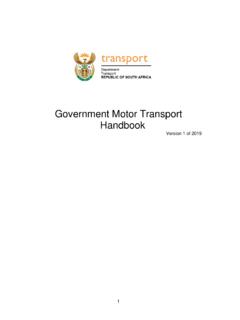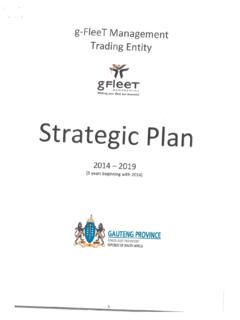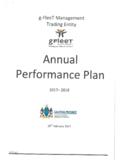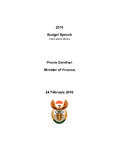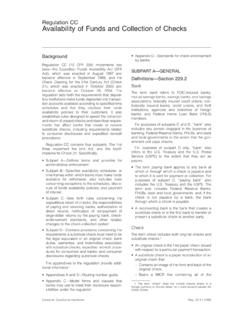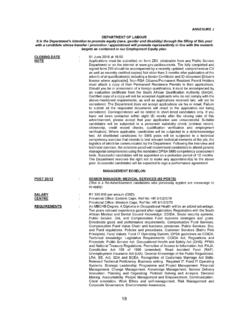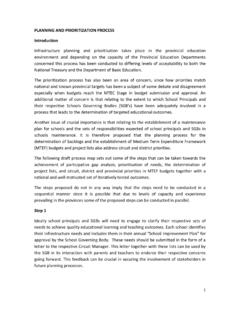Transcription of TRANSPORT POLICY - g-FleeT
1 1 TRANSPORT POLICY 1. POLICY statement TRANSPORT in the department is a tool by which service is delivered and therefore management of the resource rests with the manager responsible for service delivery . The line function head, the institutional head, the program manager and the team leader are the people responsible for the management of TRANSPORT within their organisation. The line function head will delegate the day to day operation of the resource to a TRANSPORT officer but will take overall responsibility for performance and control. This POLICY covers the use of TRANSPORT within the department. It covers inter alia the use of vehicles owned by the Provinces, vehicles permanently allocated to departments, vehicles from donor organisations, and vehicles hired by the department.
2 If vehicles are paid for by the department but managed by other organisations ( , ambulances, mobile clinics etc), the recipient organisation must ensure that their control systems are as effective as those outlined in the POLICY . They must report against the key performance indicators used by the department. This POLICY does not cover the use of subsidised vehicles, which is the subject of a separate POLICY document. This POLICY is intended to clarify the position regarding TRANSPORT as stated in the Public Service Regulations. TRANSPORT within a department is supplied as a tool to support the department in the delivery of its objectives. It must therefore be used in the most cost-effective manner. The Provincial TRANSPORT division is responsible for the ongoing development of a POLICY framework and an operational management system for all departmental TRANSPORT .
3 They will provide technical support to the TRANSPORT officers and managers within the province, co-ordinate departmental TRANSPORT management and consolidate management reporting. They will also operate a provincial pool of vehicles that can be accessed through TRANSPORT officers when local resources are fully committed. 2. Framework In support of the POLICY Statement and governing principles as stated in the Public Service Regulations, the following control mechanisms as part of the plan for implementation are of relevance (i) Who can use a vehicle A departmental vehicle can be used by any person with the authorised trip authority involved in an activity in line with the objectives of the department. The loaning of vehicles to other departments is at the discretion of the manager responsible for the TRANSPORT .
4 The manager must ensure that the organisation borrowing the vehicle will meet the operational control requirements of this POLICY . Vehicles cannot be used for party 3 political purposes under any circumstances, or to take part in industrial union activities. (ii) Drivers A departmental vehicle can only be driven by a government employee or an employee appointed in terms of Treasury Instruction S3, provided the S3 contracted employee has a clause contained in the contract stating that for government TRANSPORT purposes this employee is regarded as an employee of the state. An addendum to this effect must be added to the contracts of existing S3 contract employees. The driver must have an unendorsed valid driver s license. The TRANSPORT officer must check the license for validity.
5 The driver must have no outstanding TRANSPORT related disciplinary action against them at the time of taking the car. Where necessary, drivers must be in possession of a Professional Drivers Permit. (iii) Passengers Passengers carried by a government vehicle must be authorised to travel in the vehicle. The picking up of casual passengers is not allowed under any circumstances. The driver of the vehicle will be held responsible for ensuring that unauthorised passengers are not conveyed. Family members can only be conveyed in a government vehicle if the line manager signing the trip authority has approved a prior application. The TRANSPORT officer will hold the approval on file for at least three years. Family members travel at their own risk and the department accepts no responsibility for them.
6 (iv) Authority to use a vehicle All movements must have a signed trip authority before the vehicle is moved. In normal circumstances a trip authority must be authorised by an official of assistant director level or above, who is senior to the person travelling and is in their direct management line. In circumstances where this is not possible, alternate signatories must be identified locally. A faxed trip authority is an acceptable document. If a vehicle is moved in an emergency, a trip authority must be obtained immediately after the event, or within 24 hours of the movement. This process is only to be used in a case of extreme emergency and the manager must be satisfied that the journey was necessary. If a vehicle is based with a member of staff away from the office ( a school health nurse operating from home), then a trip authority can be issued against a weekly or monthly work plan.
7 Trip authorities must not run longer than one week at a time. As a good rule, TRANSPORT between residence and work is deemed private. (v) Issuing of vehicles All vehicles should be issued on the day of travel unless advance authority to park the vehicle at home has been obtained. The driver must carry his/her license and produce it for the TRANSPORT officer upon request. The signed trip authority must be carried in the vehicle with a copy placed on the file at the TRANSPORT office. The intended time of departure and return is to be recorded on to the vehicle issue form and compared against the actual time of return. Continued late return of vehicles may lead to a refusal to allocate vehicles in the future. The TRANSPORT officer will complete a vehicle issue form, recording the condition of the vehicle, quantity of fuel in the tank, log book and petrol card numbers.
8 The driver will sign this. The driver then takes responsibility for the vehicle at that point. The vehicle will be checked in using the same process. The driver must hand in all petrol/diesel/oil purchase slips to the TRANSPORT officer for checking after each trip. (vi) Parking a vehicle overnight In normal circumstances vehicles must be parked at official locations. The TRANSPORT officer must allocate an approved parking place for each vehicle. The parking places should be lockable or with 24 hour security available. When the vehicle is away from it s home base, the driver must use a steering or gear lock on the vehicle. Where secure facilities are not available, the vehicle should be parked at the nearest official property. The driver of the vehicle is responsible for ensuring that the vehicle is parked as safely as circumstances permit.
9 Parking charges for the use of secure parking will be refunded. Permission may be given for a vehicle to be parked overnight at a home of an official if the following conditions are met. a) the location has been reviewed by the TRANSPORT officer and security is considered adequate, There is a garage or lockable gates and, b) the member of staff will be leaving early morning or returning late at night. The actual times that this would come into force would be the time when public TRANSPORT starts / stops. Exceptions can also be made if the personal security of the individual is also at stake, or c) If the home of the individual is at a place between the office and their destination such that it is not sensible to come into the office (normally a journey saving of at least 25 km would be expected), or d) If the individual works from home or, e) The individual is on call and there is no means by which they can be transported in event of a call out.
10 A signed authority form to park a vehicle at home must be issued. The person responsible for signing trip authorities must sign it. It will normally be issued for each occasion. However, for those on call, blanket permission can be issued for a specific time period. The permission is subject to review and can be withdrawn at any time. 5 Whilst a vehicle is parked at home it may not be used for any private purposes. If an emergency arises and it becomes necessary to use the vehicle, a signed trip authority for the movement must be obtained within 24 hours of the journey. Private use of the vehicle whilst parked at home will lead to the withdrawal of the privilege and possible disciplinary action. (vi) Log books, petrol cards, vehicle keys, vehicle equipment The driver takes responsibility for the logbook, keys and petrol card once the vehicle issue form has been signed until the vehicle has been returned to the TRANSPORT officer at the end of the journey.
